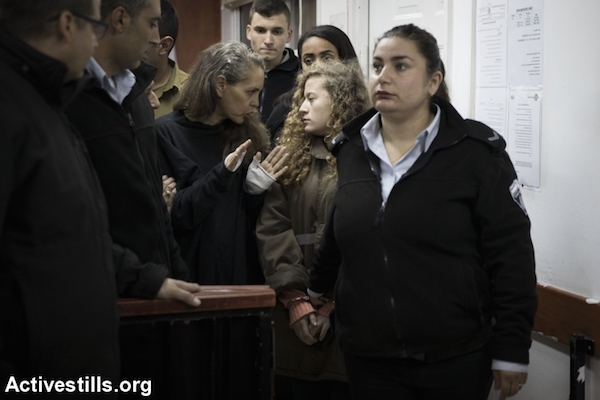Gaby Lasky, the human rights attorney representing Ahed Tamimi and her mother Nariman, talks to +972 about what it means for a Palestinian to be put on trial in the occupier’s military courts, and some of the dangerous precedents being set.

The video of 16-year-old Ahed Tamimi confronting two Israeli soldiers outside of her home in the village of Nabi Saleh has become ubiquitous, broadcast across every media platform for weeks. So have the pictures of Ahed, handcuffed and surrounded by guards in court. Posters of Ahed have even appeared on bus stops in London. What those images often fail to properly convey is that Ahed is being detained in a military prison and being tried in a military court, and how that differs from the way a minor would be treated in an Israeli civilian court.
Attorney Gaby Lasky represents Ahed Tamimi and her mother, Nariman. Lasky, a former secretary general of Peace Now and a member of the Tel Aviv-Jaffa City Council for the left-wing Meretz party, has spent much of the last decade defending Palestinians, many of them involved in the popular struggle against the occupation.
I spoke with Lasky on Thursday about the challenges of working in Israeli military court, where 99.7 percent of Palestinian suspects are convicted; about the cases against Ahed Tamimi and her mother, Nariman; and about the structural injustices built into the Israeli legal system in the occupied territories.
The difficulty of Ahed’s case goes beyond the legal challenges Palestinians living under occupation face when arrested by the Israeli army, Lasky told me. “The video shows the essence of the conflict between Israel and the Palestinians,” she stressed. Depending on where you stand, and perhaps who you are, watching the 16-year-old girl face down two heavily armed Israeli soldiers can reinforce either the Palestinian and Israeli narrative.
The following has been edited for length.
What does it mean that the judge is wearing the same uniform as the prosecution?
The military court is not a court of justice in the regular sense; it’s an organ of the occupation. It perpetuates the occupation. Both the judge and the prosecution are wearing the same uniform, and are part of the same system, and the defense is not.
What are some of the obstacles in a case like Ahed’s that would be different if she were being tried in a civilian court?
First, it would be much, much easier to get her released from detention. I brought to court a lot of examples of adults who were released in cases where their offenses were greater than hers. [Civilian] courts in Israel do tend to release [suspects on bail]. Her being a minor would have made things even easier in an Israeli court. Cases in military court are more difficult from the get-go much because the laws are stricter, the charges are heavier, and rights are only partially protected.
But the difficulty with Ahed’s case is not only that we’re facing a military court; it’s the fact that the video shows the essence of the conflict between Israel and the Palestinians. Someone can see the narrative of the Palestinians in that video, and on the other side, Israelis can see the narrative of Israel in that video.
When you talk about an offense in a regular court, you can always talk about the circumstances of the incident. In this case, the circumstances are a 16-year-old girl who was born into occupation. The military court doesn’t take those things into consideration. It’s not an issue that is brought to the table. It’s a given. But if you want to see the whole picture, you have to talk about these things.
What is the case against Ahed?
The most serious charges against her are the ones regarding the video incident. She has 12 different charges in her indictment regarding five different incidents. Regarding the video, she’s charged with assault of a soldier, disrupting the work of a soldier, and incitement.
She has other charges regarding stone-throwing but they are old — one of them is almost two years old. Nobody thought to report it or arrest her or question her at the time. The evidence against her regarding all of the other incidents was produced only after she was arrested and they found old pictures of Ahed [on her mother’s Facebook].
But it was only after her arrest that soldiers were asked to come and give testimony regarding what they saw two years ago. They were presented with these pictures after she was in every newspaper or television program, and then asked if they could identify her in a photo line-up. That’s how they obtained all of the evidence against her.
What is the case against Nariman, Ahed’s mother, who was arrested hours after her daughter? Would a civilian court ever consider live-streaming on Facebook as a form of incitement?
It’s really dangerous that the prosecution is implying that live-streaming is the worst form of incitement. It would mean that a reporter doing a live report at a demonstration where someone says, “come join us in the demonstration,” would constitute incitement in the eyes of the prosecution. What the prosecution is trying to do is very dangerous for freedom of the press.
Ahed’s case has been all over the news, getting a lot attention for a case in Israeli military court. But what aren’t we hearing about? What’s not getting out to the public?
Most people don’t know that the occupier has courts that put on trial people living under occupation just because they don’t follow the rules of the occupier. The Israeli public doesn’t want to hear about the occupation, and it’s the same for the court of the occupation.
It is amazing that a 16-year-old youngster has forced everyone to have an opinion about the occupation, to have to deal with the fact that people are born into occupation, that their rights are infringed upon, and that they’re taken to prison when they’re 16 years old for offenses that don’t merit detention in Israel.
Some in the Israeli public think the soldiers behaved as they should, others say they were humiliated. It was this humiliation that brought about Ahed’s arrest. But even so, everyone now has to deal with the occupation and what it does to the soldiers and to the people who live under occupation. Even without wanting to, Ahed’s case opened a door that has been closed for a long time for most of the public in Israel.

